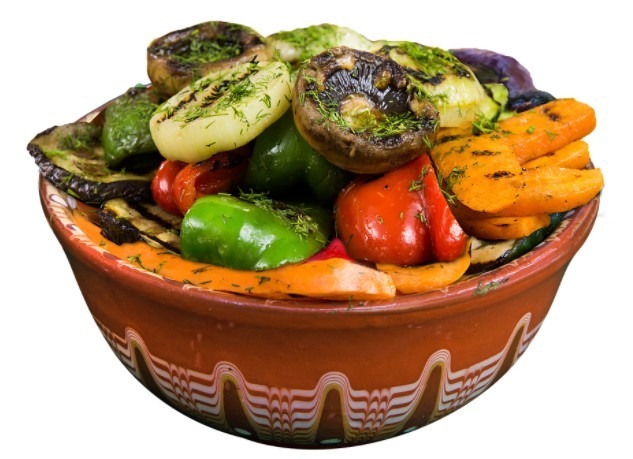Bulgarian food is not just flavorful, but they’re also hearty, savory, and fresh. Bulgaria is famous for its dairy products and quality vegetables, and its different mild spices. Chicken and pork are some of the most common forms of meat used in Bulgarian dishes, although food with veal, fish, and seafood in them are also popular. Lamb also has its special place in traditional Bulgarian cooking.
Several of the staples of Bulgarian cuisine can also be found in Serbia, Turkey, or Greece. Still, Bulgaria has differentiated its own from its Balkan neighbors’ version with their local flavor. Here are the top 5 Bulgarian dishes you must try when you’re in the country, from grilled meat classics and hearty salads to delicious pastries.
1. Lyutenitsa (лютеница)
A childhood favorite for Bulgarians, this thick relish of peppers and tomatoes is their favorite thing to put on their toasts. At present, the Lyutenitsa is commercially produced to be sold in small jars. So when an aroma of roasting peppers coming from balconies in Bulgarian homes during autumn hits you, you will know that homemade Lyutenitsa season is slowly approaching!
Due to the cumin, onions, and garlic ingredients in Lyutenitsa, the dish is always going to be, at least, spicy in taste— which it owes its name and popularity to. The somewhat spicy dish is particularly a favorite among children. Parents understand that Lyutenitsa spread on a slice of bread topped with a sprinkle of sirene cheese (as every food seems to be in Bulgaria) is one of the rare ways of persuading their children to eat a snack in between several rounds of hide-and-seek in their neighborhood.
2. Shopska Salata (шопска салата)
The Shopska Salata is an internationally renowned Bulgarian dish. This salad is a simple yet effective combination of diced peppers, tomatoes, onions, and cucumbers, topped with parsley and grated sirene cheese. Whether an invention of Balkantourist: communist Bulgaria’s state-owned tour operator in the 1950s or a century-old meal of the Shopi ethnographic group (as its name suggests), the Shopska salad is the perfect tasty partner to a shot of rakia at the beginning of a Bulgarian meal.
Peculiarly, Shopska Salata’s most noticeable colors are red (the peppers and tomatoes), white (the cheese), and green (the cucumbers), which perfectly match the colors of the national flag of the country. An obvious hint as to the salad’s crucial role in Bulgarian cuisine.
3. Musaka (мусака)
This goodness upon goodness dish is greatly enjoyed in several variations throughout the whole Balkan region. The Bulgarian version includes minced pork, potatoes, and eggs. It’s also a distinguished favorite of Bulgarian men, which had developed a popular joke that they can’t marry a woman who cannot cook the perfect Musaka.
Unlike the Greek Musaka variety that might be based on eggplant, the Bulgarian version strictly relies on potatoes in layering the meat. In addition, the whole dish is traditionally covered with a thick Bulgarian yogurt atop it.
4. Banitsa (баница)
You can purchase this baked extravaganza in bakeries all across Bulgaria. This piece of delicious greasy pastry’s regular variety incorporates a feta-like white cheese (сирене, sirene) filling. However, you can also find several types filled with cabbage, mushrooms, pumpkin, onions, or spinach.
For those with a sweet tooth, you can try the banista with walnuts and apples. The dish in every one of its forms is a vital part of the traditional Bulgarian breakfast. Couple it with a thick fermented wheat drink Boza for the ultimate Bulgarian experience.
A tip for the holidays: Be mindful when chewing your piece of banista during Christmas or New Year’s eve since, during those dates, the banista is packed with lucky paper charms that are often easy to bite through. The most fortunate piece will hold a coin, meaning you’ll have a very successful year before you.
5. Kebapche (кебапче)
The Kebapche is a cousin of the Romanian Mititei and former Yugoslavia’s famous ćevapčići. This Bulgarian side dish is the perfect companion to a glass of cold Bulgarian beer during the summer. Even though the country’s residents may argue about whether the beer is a Zagorka or a Kamenitza, it makes no considerable difference. The essential part is that the kebapcheta is at least three, including some types of sides (usually French fries topped with grated sirene cheese) to create the classic “three kebapcheta with sides.”
The Kebapche itself is an elongated piece of grilled minced meat comparable only in size and shape, not in content, to a hotdog. The smaller ćevapčići that you can enjoy in Serbia’s meat is typically a blend of beef and pork, though it can just be pork. A beef version also exists but is not typical and will usually be identified as such. Typically, spices like cumin and black pepper will be added to the meat for a mild-spicy taste.
